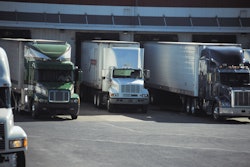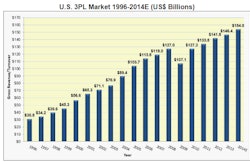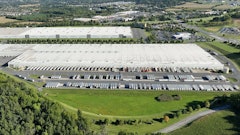
Recent surveys of the third-party logistics (3PLs) industry are uncovering similar findings when it comes to how 3PLs are repositioning themselves in the market. In short, many 3PLs are seeking to avoid commoditization by offering value-added services to customers while strengthening the relationship between the two parties.
Food Logistics asked a handful of 3PLs with a significant presence in the food/beverage sector their thoughts about how customers can ‘get more’ from them while maintaining a mutually beneficial arrangement.
“With capacity levels at an all-time high and little relief in sight, building relationships with your core transportation service providers has never been more important,” states (exec name here), from Choptank Transport. “Shopping by price alone, and not service and reliability, will leave many shippers with big problems when seasonal surges occur and there is tightened capacity. Maintaining a strong supply chain will help ensure operations continue to run smoothly, without interruption due to lack of capacity.”
Indeed, the capacity crunch is only getting worse. The American Trucking Associations estimates the industry is short by roughly 30,000 truckers nationwide while the improving economy is straining an already extremely tight market. It’s no wonder that more shippers have come to appreciate the value of building a relationship with their 3PLs in the current environment.
Robert Nathan, CEO of Load Delivered Logistics, LLC, also advises shippers to focus on relationships as they look for ways to optimize their transportation and logistics strategy.
“The first step towards getting more out of your 3PL is consolidating your carrier network. To maximize 3PL performance, shippers must create mutually beneficial, dedicated relationships with their logistics providers That means working with fewer, more specialized carriers, creating open lines of communication and focusing on automation tactics and technology,” he says. Additionally, “If you ship perishable products, working with a ‘Jack of All Trades’ 3PL will only harm your cold chain,” says Nathan. “Instead, focus your transportation spend on logistics providers who specialize in what you ship—those providers have relationships with the right carriers and the knowledge and experience to handle your product safely. Once you choose the right 3PL, increasing integration and automation with your provider will ensure that both parties are accountable, accurate and as efficient as possible.”
Relationships are naturally a two-way street, and at OHL a considerable amount of effort is placed on customer service as a foundation for building a relationship.
“The customer relationship and strong collaboration should be at the heart of the services the 3PL provides,” says Sean Kelly, senior vice president, food and beverage vertical. “At OHL, one of our core values is to provide customers with superior customer service that drives continuous improvement through operational excellence, innovation and flexibility.”
To enhance customer service and collaboration, OHL incorporates several vital components into its relationships with customers, including strong account management with regularly scheduled meetings and ongoing communication; forecasting tools and metrics that are contractually tied to account performance outcomes; and continuous improvement programs, such as OHL’s Making Our Customer Great, that includes evaluations of customers’ supply chains to identify opportunities for quality improvement and best practices that can be shared throughout OHL’s customer base.
Kenco’s Todd Johnson, senior vice president, operations, suggests the best way for shippers to boost the return on their 3PL investment is “to have a strong cultural fit with your logistics providers and create long-term goals.”
He emphasizes that, “Cultural fit can be the single most important element of a successful 3PL partnership, since the chemistry between the two companies—and the people who work for those companies—can make or break a business relationship.”
When companies share values, communication occurs naturally, interactions are productive, and success in ongoing, says Johnson.
“Trust is a big component. If you can avoid micromanaging every transaction with your 3PL, then both of you can focus on the results,” he says. “To do this, the partners should capitalize on their strengths and be equally invested in each other’s success.”
According to Johnson, many companies start working with a 3PL to fix an isolated problem at the lowest possible cost. However, those relationships are usually temporary and only fill an operational gap. On the contrary, a thoughtfully planned 3PL partnership, with a strong cultural alignment, can produce invaluable system-wide results that focus on sustainable operational gains, rather than a temporary price break.
Choptank Transport’s (exec name here) agrees with the idea of leveraging relationships to uncover opportunities for cost savings throughout the supply chain.
“Always ask your 3PL for suggestions regarding possible cost savings,” he explains. “Opportunities to save on pricing can range from a change in palletization, alternate days and routes for shipping, intermodal options, and volume pricing.”
While moving from a transactional relationship to a collaborative one may not come easy for some shippers, “Open books are easier to read,” proposes Blair Thomas, director of customer care at Columbian Logistics Network. “Sharing information with your 3PL shouldn’t be considered a loss of control. Consider it an investment into partnership.”
Thomas advocates pushing the boundaries of that partnership into new territory. For example, instead of putting the sourcing of supply chain services into the hands of the purchasing department, “We recommend letting the supply chain professionals handle the sourcing in order to produce a more collaborative solution.”
He adds that, “For better visibility and control of your inventory, consider putting the 3PL on your IT system’s platform. It’s become more common and 3PLs can often provide the operational expertise you’re looking for without the cost and headaches of EDI or other communications integration.”
Load Delivered Logistics’ Nathan underscores the key role of software and technology in the overall relationship between shippers and 3PLs.
“The supply chain and logistics world is quickly changing. Gone are the days of faxing and emailing—the name of the game is automation and technology. In pricing, warehousing, billing and sourcing alike, manual processes are being streamlined and automated, allowing for increased, high-level analysis and growth. Shippers who adopt automation and find 3PL partners who do the same will be the ones escalating the customer experience and leading the way for the next generation supply chain.”
[BOX] For more information:
Choptank Transport 800.568.2240, www.choptanktransport.com
Columbian Logistics Network 888.609.8542, www.columbianlogistics.com
Kenco 800.758.3289, www.kencologisticservices.com
Load Delivered Logistics, LLC 877.930.5623, www.loaddelivered.com
OHL 877.401.6400, www.ohl.com



















